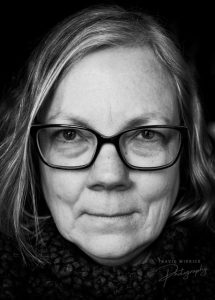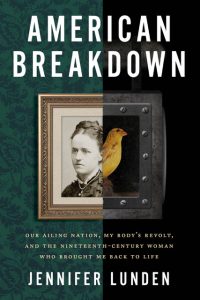Talking About Women’s History: A Bunch of Questions and an Answer with Jennifer Lunden
Jennifer Lunden (she/her) is the author of American Breakdown: Our Ailing Nation, My Body’s Revolt, and the Nineteenth-Century Woman Who Brought Me Back to Life, which was praised by the Los Angeles Review of Books and Washington Post, and called a “genre-bending masterpiece” by Hippocampus. The recipient of the 2019 Maine Arts Fellowship for Literary Arts and the 2016 Bread Loaf–Rona Jaffe Foundation Scholarship in Nonfiction, Lunden writes at the intersection of health and the environment. Her essays have been published in Creative Nonfiction, Orion, River Teeth, DIAGRAM, Longreads, and other journals; selected for several anthologies; and praised as notable in Best American Essays. A former therapist, she was named Maine’s Social Worker of the Year in 2012. She and her husband, the artist Frank Turek, live in a little house in Portland, Maine, where they keep several chickens, two cats, and some gloriously untamed gardens.
Take it away, Jennifer!
What inspired you to write American Breakdown?
I’d been disabled by what’s now known as myalgic encephalomyelitis/chronic fatigue syndrome, or ME/CFS, for five years when I stumbled upon Jean Strouse’s brilliant 1980 biography of Alice James in a used bookstore. I knew Alice was the sister of the nineteenth-century author Henry James and the psychologist William James, and that she spent much of her life bedridden by a mysterious illness. So I bought the book. It changed my life. Alice’s symptoms and mine were so similar I wondered if our illnesses might be one and the same, and I wondered if anyone else had made that connection.
In 2001 I asked a research librarian to help me search for papers connecting ME/CFS with Alice’s illness, neurasthenia, and she found a handful. Reading and researching was something I could largely do in bed, and I began doing so voraciously.
I wanted to write a book about ME/CFS and multiple chemical sensitivity because the biased perceptions faced by those of us who suffer from these and similarly misunderstood illnesses from doctors, researchers, the media, and the general public is harmful to our health. The further I delved into my research, however, I could see that America’s rapacious form of industrial capitalism is bad for all of us. So, like the ripples around a stone tossed in the water, my story started with Alice and me and expanded outward.
In American Breakdown, you combine memoir, biography and medical history to produce a complex exploration of industrialization and its impact not only on the environment but on healthcare in the United States. How did you navigate the narrative requirements of three very different types of storytelling?
What I love about the braided narrative is that it allows for a telling that includes head and heart. In other words, it is a way to connect mind and body. This was especially important to me because one of the key themes I tackle in the book is the problems posed by the limitations of our dualistic approach to medicine and to life in general. Biologically, and ecologically, we’re much more complex than that, and that’s a beautiful thing.
I knew that I wanted to include data and research that legitimized my experience and the lived experiences of others who, like me, live with the poorly understood, complex, multi-system illnesses that primarily strike women. I wanted skeptics to be able to read my book and know they could turn to the endnotes and see that what I was saying was backed by peer-reviewed research.
But I also knew if I didn’t include story that the book would be dry and hard to get through. So as I was interweaving the strands, I listened to my body, which told me when the facts were getting to be too much, and I would break there and put in a segment from my own story, or Alice’s.
And even when I was writing about dualism, I started by reading one or two biographies of Descartes, who is attributed as the thinker behind dualism, and I wove some of his story into the narrative about dualism.
We learn more effectively through story than through data; I felt that I could broaden people’s perspectives about these contested illnesses by opening their hearts through my illness story, and Alice’s.
Writing about a historical figure like Alice James requires living with her over a period of years. What was it like to have her as a constant companion?
Finding Alice felt like finding my kindred spirit, my illness comrade. Alice was witty and whip-smart, and, like me, often bedridden due to a poorly understood illness.
Here’s an Alice quote that still makes me laugh out loud, written to a friend when Alice was 31:
Ill-health though not an exceptional or tragic fate inevitably brings a certain monotony into the lives of its victims which makes them rather sceptical [sic] of the much talked of and apparently much believed-in joy of mere existence.
And when she was diagnosed, at 42, with breast cancer, her response wasn’t what most people would expect, but it deeply resonated with me. As she enthused in her diary, finally, and to her great relief, she was lifted “out of the formless void” and set down “within the very heart of the sustaining concrete.”
While most of us chronically disabled by similar illnesses aren’t ready to embrace death the way Alice was, I suspect that just about anyone who has contended with ME/CFS, multiple chemical sensitivity, long Covid, or any one of a number of other poorly understood illnesses can identify with Alice’s relief at finally receiving a concrete diagnosis, one recognized as “real” and valid in their world.
Alice’s doctor, “the blessed being,” had also “endowed” her with “not only cardiac complications,” but also a “most distressing case of nervous hyperaesthesia” (hypersensitivity of one or more of the senses of sight, sound, touch, and/or smell). These, she wrote triumphantly,
added to a spinal neurosis that has taken me off my legs for seven years; with attacks of rheumatic gout in my stomach for the last twenty, ought to satisfy the most inflated pathologic vanity. It is decidedly indecent to catalogue oneself in this way, but I put it down in a scientific spirit, to show that though I have no productive worth, I have a certain value as an indestructible quantity.
Here, while reveling in her concrete diagnoses, Alice simultaneously pushes against capitalistic definitions of human worth and expands the definition of our value. It’s an early expression of disability pride.So I would say that Alice resided in my heart over the many years it took to write this book. She helped to sustain me.
How did your training as a social worker and therapist inform your work on American Breakdown?
I didn’t realize until 2017, when I began teaching a foundational graduate social work course called Human Behavior in the Social Environment, how social-worky American Breakdown is. Social workers are trained to look for the contexts contributing to the personal difficulties people are facing. My curiosity about the sociocultural contexts that influenced my biology, and Alice’s, took me on a journey beyond anything I envisioned when I started writing—research that included American history, of course, and biology, but also nineteenth-century and contemporary toxicology, medical history, economics, environmental history, sociology, chaos theory, and more, and the process of synthesizing what I learned into a narrative interwoven with both my story and Alice’s was deeply illuminating.
What work of women’s history have you read lately that you loved? (Or for that matter, what work of women’s history have you loved in any format? )
Well, I’ve only just started reading it, but I highly recommend National Book Award winner Tiya Miles’s new book Wild Girls: How the Outdoors Shaped the Women Who Challenged a Nation.
A question from Jennifer: I see that, in addition to Women Warriors and the forthcoming The Dragon from Chicago, you are also the author of The Everything Guide to Understanding Socialism. How do your understanding of socialism and your interest in women’s history inform each other?
I must admit that I am interested in many, many things and the relationships between them in my head are more like a tangled knot of yarn than a web.
In the case of socialism and women’s history, the most obvious link is that I have long been interested in women’s involvement in social reform movements in the mid-nineteenth to the earlier twentieth century, whether we’re talking about Jane Addams and her colleagues at Hull House or Mother Jones and the labor movement. That link shows up clearly in my book on Civil War nurses, for example.
Other threads leading into that knot of yarn are fundamental interests in stories that stand outside the primary historical narrative (labor history and women, for example), how social change happens, and the people I call shin-kickers.
***
Want to know more about Jennifer Lunden and her work?
Check out her website: https://jenniferlunden.com/
***
Come back tomorrow for two, or five, questions and an answer with Natalie Dykstra, author of Chasing Beauty: The Life of Isabella Stewart Gardner






